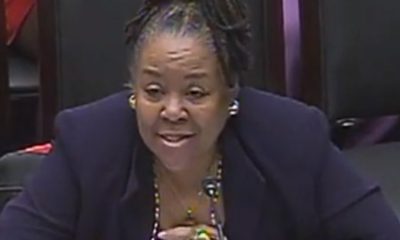Black History
COMMENTARY: Changing the rigged game that perpetuates inequality
MINNESOTA SPOKESMAN-RECORDER — Today, while we live in a society that has passed a litany of civil rights bills and other legal protections, rampant social inequality continues to exist.
By Clarence Hightower
It’s not enough to know that there is a great deal of inequality in the United States and around the world. We need to know not only how much, but also how. If we can see how the rules of the game are rigged to create and sustain inequality, we can see how they might be unrigged — how a different set of rules and arrangements might be created. — Michael Schwalbe
A little more than a century ago, German sociologist Max Weber famously put forth a theoretical model which, when translated to English, become known as the “iron cage.” In essence, the concept of the “iron cage” is that people are forced and confined to their social condition based on the “teleological” agenda of a government or bureaucracy.
Teleology can be defined as “the reason or explanation for something in the function of its end, purpose, or goal.” Put another way, if a ruling body rationalizes that a certain population is inferior (morally, physically, intellectually, etc.), then they basically have the lawful authority to oppress that population.
In his 1979 classic book Iron Cages, Ronald Takaki, the late historian and forerunner in the arena of ethnic studies, demonstrates how White attitudes toward populations of color — which were, in large part, fueled by pseudo-science and quasi-medicine, propaganda and untruths, and other strategies of domination — shaped the foundation of race and culture in the United States.
Such strategies were used as a justification for slavery and Jim Crow, the forced removal and genocide of indigenous people, and the historic marginalization of other “minorities” including Mexican and Chinese people. Moreover, the legacy of these policies, practices and attitudes continues to permeate American culture today in myriad ways, some easily seen, others unseen.
Today, while we live in a society that has passed a litany of civil rights bills and other legal protections, rampant social inequality (particularly among those of color) continues to exist. And, not only are many of those aforementioned laws under constant threat, but there are scores of systematic tools and tactics that counter any movements to effect change and bring about increased equity.
Sociologist Michael Schwalbe identifies a number of these dubious tactics in his book Rigging the Game: How Inequality is Reproduced in Everyday Life. Schwalbe expands on the writings of Takaki (and others like Michael Omi and Howard Winant) in exploring the “roots of inequality” in America and links it to how the game is still rigged today in favor of the wealthy and powerful.
This, of course, relegates the poor, people of color, women, and others to the margins of society; or to their “iron cage.”
Among the tools that reproduce and sustain inequality, Schwalbe identifies neighborhood redlining, tax breaks and loopholes for the rich, voter suppression and gerrymandering as well as barriers to employment and education (or “getting in the game”). He also speaks to some of the “legal” definitions of the day, such as “money is speech” and “corporations are people.”
These realities allow the wealthy to become even more adept at “making government serve their interests.” This, in turn, undermines our democracy.
Without question, none of this is new to most Americans. Nonetheless, this is the arena in which our fight against poverty, racism, and injustice must take place. We must continue to call out and challenge the so-called rules that “rig the game.”
We must not surrender to the idea that nothing can be done. We must resist and conquer the narrative that continues to “blame the victims” for their plight. And perhaps more than anything else, we must see and respect one another as human beings.
As Schwalbe concludes, “A rigged game, one that creates and perpetuates inequality…diminishes our humanity. If we want to do better than this, we need to critically analyze the rigged game in which we’re caught and which we help to reproduce. The next step is to change it.”
This article originally appeared in the Minnesota Spokesman-Recorder.
Activism
Oakland Post: Week of April 24 – 30, 2024
The printed Weekly Edition of the Oakland Post: Week of April 24 – 30, 2024

To enlarge your view of this issue, use the slider, magnifying glass icon or full page icon in the lower right corner of the browser window. ![]()
Activism
Oakland Post: Week of April 17 – 23, 2024
The printed Weekly Edition of the Oakland Post: Week of April 17 – 23, 2024

To enlarge your view of this issue, use the slider, magnifying glass icon or full page icon in the lower right corner of the browser window. ![]()
Black History
Matthew Henson: Explorer Extraordinaire
Matthew Henson, a trailblazing explorer who overcame countless obstacles to leave an incredible mark on history. Born on August 8, 1866, in Charles County, Maryland, his journey is a testament to the power of determination and the spirit of adventure.

By Tamara Shiloh
Matthew Henson, a trailblazing explorer who overcame countless obstacles to leave an incredible mark on history. Born on August 8, 1866, in Charles County, Maryland, his journey is a testament to the power of determination and the spirit of adventure.
Henson’s life began amidst the backdrop of post-Civil War America, where opportunities for African Americans were scarce. From a young age, he possessed an insatiable curiosity about the world beyond his small town. At the age of 12, he embarked on a journey that would change the course of his life forever when he joined a merchant ship as a cabin boy.
His most famous expedition was his journey to the Arctic with renowned explorer Robert E. Peary. In 1887, Henson joined Peary’s crew as a seaman and quickly proved himself to be invaluable with his skills as a navigator and craftsman. Over the course of several expeditions, Matthew endured extreme cold, treacherous terrain, and grueling conditions as he and Peary sought to reach the elusive North Pole.
In 1908–09, Peary set out on his eighth attempt to reach the North Pole. It was a big expedition, with Peary planning to leave supplies along the way. When he and Henson boarded their ship, the Roosevelt, leaving Greenland on August 18, 1909, they were joined by a large group. This included 22 Inuit men, 17 Inuit women, 10 children, 246 dogs, 70 tons of whale meat, blubber from 50 walruses, hunting gear, and tons of coal.
In February, Henson and Peary left their anchored ship at Ellesmere Island’s Cape Sheridan, along with the Inuit men and 130 dogs. They worked together to set up a trail and supplies along the way to the Pole.
Peary picked Henson and four Inuit people to join him in the final push to the Pole. However, before they reached their destination, Peary couldn’t walk anymore and had to ride in a dog sled. He sent Henson ahead to scout the way. In a later interview with a newspaper, Henson recalled being in the lead and realizing they had gone too far. The group turned back, and Henson noticed his footprints helped guide them to their destination. At that location, Henson planted the American flag.
Henson’s legacy extends far beyond his expeditions to the Arctic. He shattered racial barriers in the world of exploration and inspired countless individuals, regardless of race, to dream big and pursue their passions. In 1937, he was finally recognized for his achievements when he was inducted into The Explorers Club, an organization dedicated to promoting scientific exploration and field research.
Matthew Henson died in the Bronx, New York, on March 9, 1955, at the age of 88.
-

 Community2 weeks ago
Community2 weeks agoFinancial Assistance Bill for Descendants of Enslaved Persons to Help Them Purchase, Own, or Maintain a Home
-

 Activism4 weeks ago
Activism4 weeks agoOakland Post: Week of April 3 – 6, 2024
-

 Business2 weeks ago
Business2 weeks agoV.P. Kamala Harris: Americans With Criminal Records Will Soon Be Eligible for SBA Loans
-

 Community2 weeks ago
Community2 weeks agoAG Bonta Says Oakland School Leaders Should Comply with State Laws to Avoid ‘Disparate Harm’ When Closing or Merging Schools
-

 Activism3 weeks ago
Activism3 weeks agoOakland Post: Week of April 10 – 16, 2024
-

 Community2 weeks ago
Community2 weeks agoOakland WNBA Player to be Inducted Into Hall of Fame
-

 Community2 weeks ago
Community2 weeks agoRichmond Nonprofit Helps Ex-Felons Get Back on Their Feet
-

 Community2 weeks ago
Community2 weeks agoRPAL to Rename Technology Center for Retired Police Captain Arthur Lee Johnson





















































